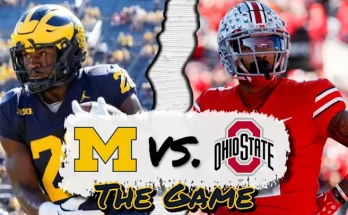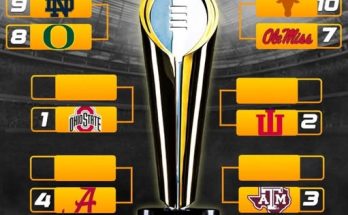Did Ohio State Football Players’ Religious Actions Become ‘Tiresome’?
Ohio State football has been a staple of college football for decades, with a reputation for excellence, remarkable talent, and national championships. Alongside its on-field dominance, the Buckeyes have a history of having players who are vocal about their faith and are unafraid to express their religious beliefs publicly. However, as college football continues to grow in popularity, the question has been raised: Do the religious actions of Ohio State football players ever become “tiresome” to fans, commentators, or the broader sports world?
While religion in sports has a long-standing tradition, the intersection between personal belief and public performance can sometimes cause discomfort or divisiveness. This article explores the role of religion in Ohio State football, the arguments for and against the public expression of faith by players, and whether these acts have begun to wear thin with audiences. Ultimately, this debate forces us to consider how we, as a society, understand and respect personal beliefs in the context of a public spectacle like college football.
The Role of Religion in College Football
Religion has always been a part of the sports world, particularly in American football, where athletes have often turned to their faith for strength and guidance. From pre-game prayers to religious gestures after a touchdown, athletes across all levels of football have used their platform to express their beliefs. The culture of college football, particularly at universities like Ohio State, has become an environment where faith is encouraged and celebrated.
Many Ohio State football players have been known for their religious expressions, whether it’s through public prayer, wearing faith-based symbols, or making religious gestures after scoring plays. The religious identity of some of these players is integral to how they approach the game, both mentally and emotionally. For players like quarterback Justin Fields, defensive lineman Chase Young, and others, religion often plays a key role in maintaining their focus and composure, helping them overcome adversity.
The Buckeyes’ commitment to faith is not confined to individual players, either. The coaching staff, led by Coach Ryan Day, has been open about the role that faith plays within the program. In fact, Day has been known to support his players’ individual beliefs, often allowing them the space to express their faith, whether it’s during practice, pre-game, or even after a tough loss. The culture at Ohio State seems to encourage players to be open about their faith, but the question arises: does this public display of belief ever become overwhelming to fans or the general public?
The Case for Religious Freedom in Sports
First, it’s important to acknowledge that religious freedom is a fundamental right. College football is, in many ways, an extension of personal freedom, as players from different backgrounds come together to pursue a common goal—winning games and competing at the highest level. This is where religion finds its place: as a personal expression of belief that transcends the boundaries of the game itself. For some athletes, faith is not just a hobby or a weekend pastime—it is an essential part of who they are.
The ability to express one’s faith, regardless of whether that faith is Christian, Muslim, Jewish, or any other belief system, is crucial to the concept of personal freedom. For players like Ohio State’s Justin Fields, religion has been an essential element in helping them maintain their composure and focus on the field. Fields himself has talked about how his faith grounds him, helping him to stay level-headed in high-pressure moments.
Moreover, religious expression in sports can be a source of inspiration for others. Many fans who watch Ohio State games do so because they find personal meaning in the way the players carry themselves. In an era when so many athletes are focused on brand-building and personal image, seeing players publicly honor their faith can be refreshing. It provides a sense of authenticity that might be lacking in other areas of the sports world. Faith-driven moments, such as prayers after a touchdown or locker room discussions of gratitude and humility, offer a different type of spectacle that can connect deeply with some fans.
At its best, religious expression in college football can inspire. It can encourage young fans to consider how faith might play a role in their own lives. For some, it’s a reminder of the values of perseverance, humility, and hard work, and how those values can be grounded in something bigger than themselves.
The Other Side of the Debate: When Religious Displays Become Tiresome
While religion can inspire, the continuous display of religious acts in a public, competitive environment like college football is not without its detractors. For some, seeing the same rituals, prayers, and religious gestures repeatedly can become tiresome. College football, at its core, is a game—a form of entertainment. Fans come to see their favorite teams compete at the highest level, hoping for thrilling plays, dramatic moments, and athleticism on full display. For some, the constant display of religious symbolism might feel like a disruption to the main event.
This argument often hinges on the idea of balance. While many fans may respect players’ right to express their faith, there’s a belief that it should not overshadow the athleticism and competition. For example, when a player prays or makes a religious gesture after every touchdown, it can feel repetitive, even if the intentions behind the actions are genuine. In the same way that excessive celebrations can be off-putting to some, religious displays can take on a similar tone when they occur with too much frequency.
Furthermore, religion, especially when it becomes a prominent part of the media narrative around a team or player, can unintentionally alienate fans who do not share those beliefs. College football, particularly a major program like Ohio State, has a fan base that is incredibly diverse. People from all walks of life, and from many different backgrounds, come together to watch the games. When religious expressions are pushed into the public spotlight—such as on national television or during post-game interviews—it can make some viewers feel uncomfortable or excluded.
This doesn’t necessarily mean that religious displays should be banned or discouraged, but there’s an argument to be made that there needs to be sensitivity around how often and in what context these displays occur. The line between personal expression and public spectacle can become blurred, and when religion enters the spotlight too frequently, it may risk turning fans away. No one wants to feel like they’re being preached to during a sporting event.
A Fine Line: Respecting Faith While Celebrating the Game
At the heart of the debate lies the delicate balance between respecting individual religious beliefs and maintaining the focus on the game itself. Players, particularly at a high-profile school like Ohio State, should be free to express their faith in ways that are meaningful to them, as long as those expressions don’t detract from the sport. It’s crucial to note that sports are not just about winning games—they are about unity, personal growth, and shared experiences. When players express their faith, they’re often doing so to reinforce these values.
However, fans and the broader public must also consider the nature of the spectacle they’re watching. College football is meant to be entertaining, and while religious displays can enhance the experience for some fans, they can feel out of place or excessive to others. It is a matter of finding a balance between respecting players’ freedom to practice their beliefs and ensuring that the focus remains on the athletic competition itself.
One solution to this dilemma could involve creating spaces where players can express their faith without making it a constant part of the viewing experience. For example, encouraging players to privately pray or practice their faith in a more subdued manner—away from the cameras—would allow them to maintain their religious practices without potentially alienating fans who are not interested in seeing it on display at every moment of the game. This would allow faith to remain an integral part of the players’ lives without overshadowing the sport itself.



